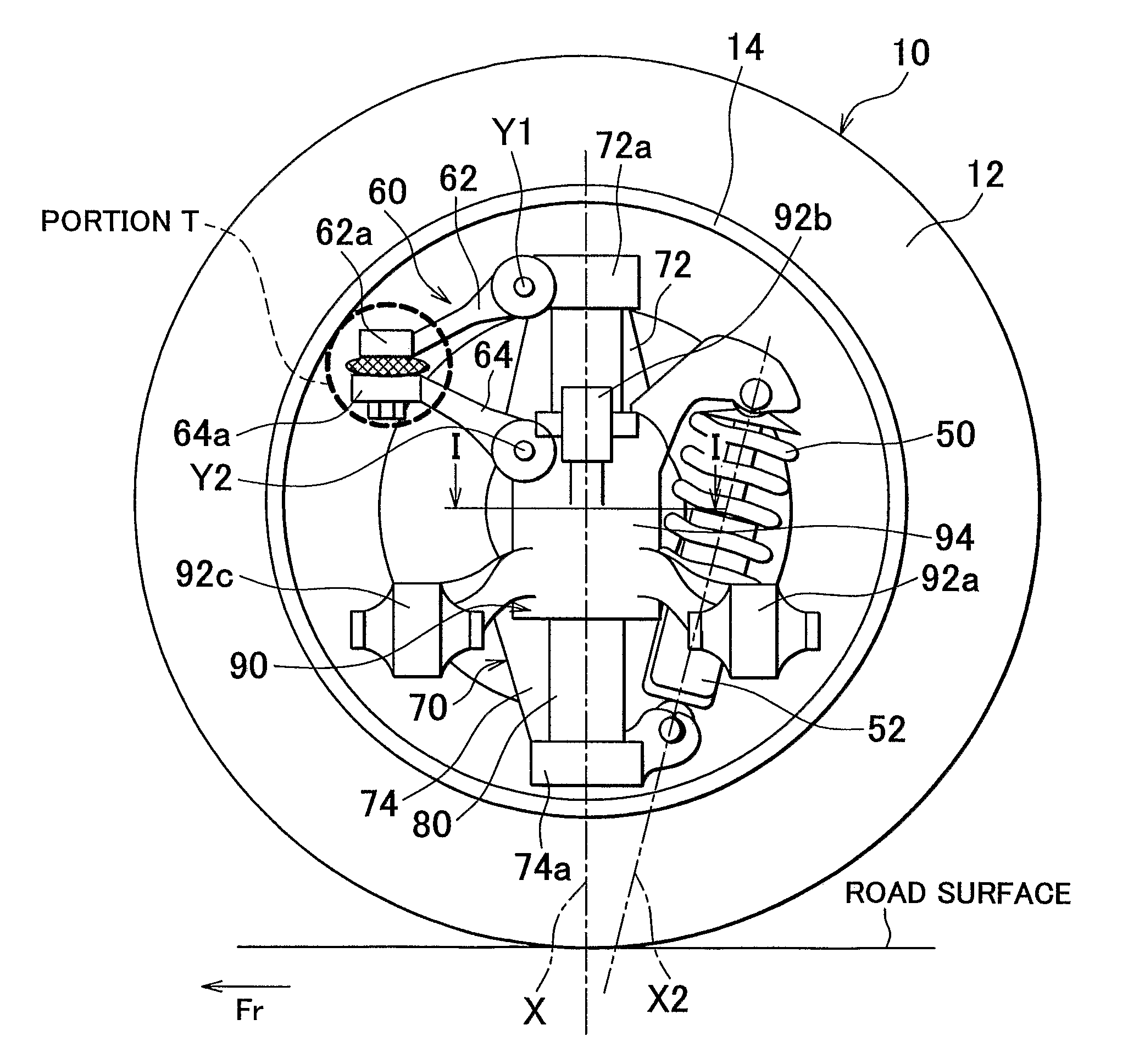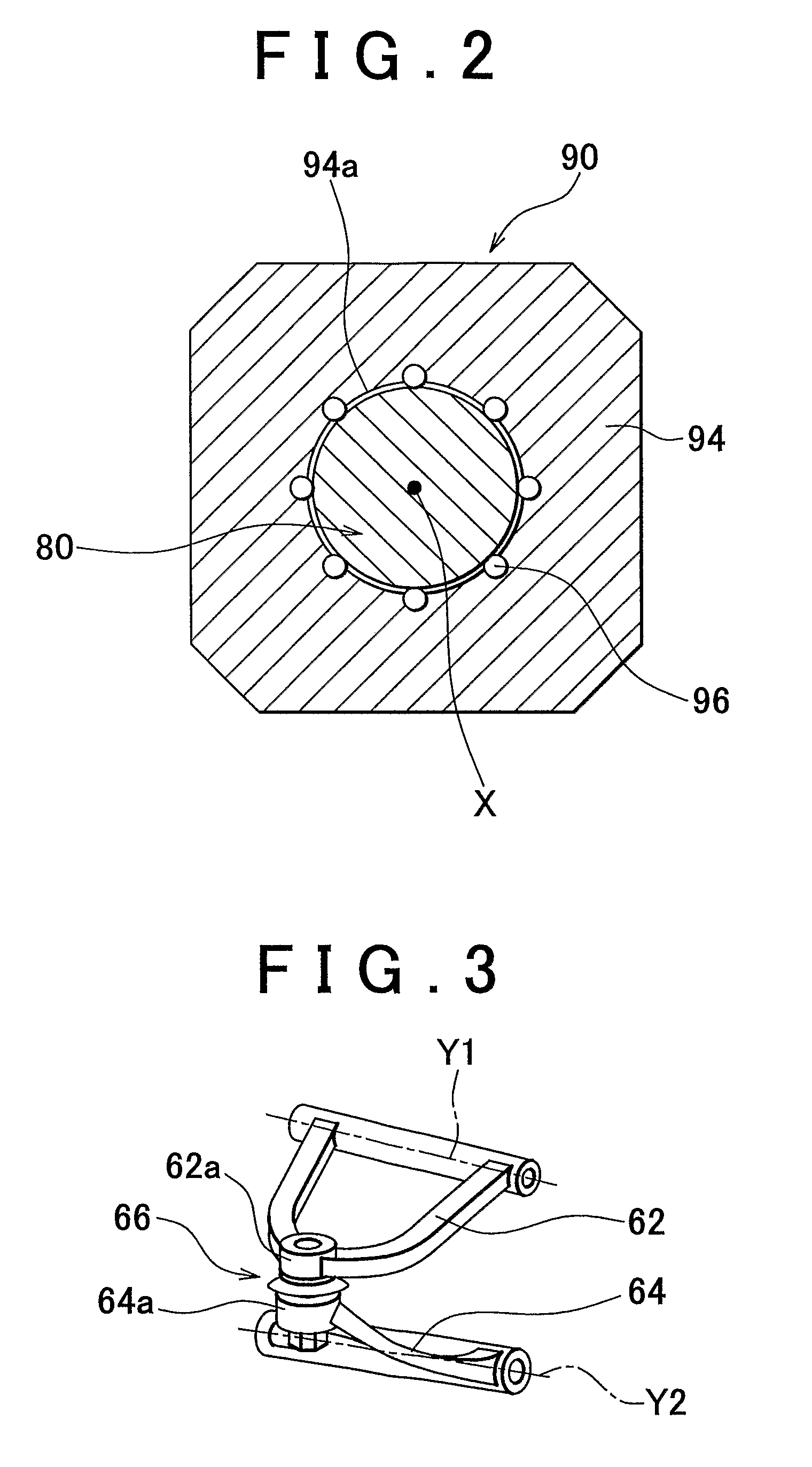In-wheel suspension
a technology of in-wheel suspension and suspension arms, which is applied in the direction of resilient suspensions, vehicle components, and pivoted suspension arms, etc., can solve the problems of reducing the advantages of in-wheel suspension, the fact that the tire/wheel assembly can only move along the sliding sha
- Summary
- Abstract
- Description
- Claims
- Application Information
AI Technical Summary
Benefits of technology
Problems solved by technology
Method used
Image
Examples
first embodiment
[0043]Accordingly, in the first embodiment, the pivot axes Y1 and Y2 are arranged such that the extended lines of the pivot axes Y1 and Y2 form a predetermined angle θ (see FIG. 4) that is greater than zero degree, instead of being arranged in parallel with each other, when viewed from the rear of the vehicle. As described later, the predetermined angle θ is a parameter that defines the characteristics of changes in the toe-angle of the tire / wheel assembly 10 when the tire / wheel assembly 10 jounces / rebounds. The predetermined angle θ is set such that the toe-angle is changed by an intended amount. For example, the predetermined angle θ may be set to a value greater than zero degree and less than five degrees (0°<θ<5°).
[0044]FIG. 4 illustrates the view for describing the principle of a change in the toe-angle, which is caused in response to the operation of the coupling member 60 (the arms 62, 64) when the tire / wheel assembly 10 jounces / rebounds. To facilitate the understanding of th...
second embodiment
[0053]Similarly, the carrier 70 and the vehicle body-side member 90 are coupled with each other by the coupling member 60. The vertical / substantially vertical movement of the carrier 70 along the central axis X of the shaft member 80 is permitted, while its rotation on the central axis X of the shaft member 80 is restricted. In the second embodiment, as shown in FIG. 5, the pivot axes Y1, Y2 of the coupling member 60 (the arms 62, 64) extend in the longitudinal direction of the vehicle, as in the structure shown in FIG. 4. However, the pivot axes Y1, Y2 may extend in any directions, when viewed from the top of the vehicle. Thus, a certain degree of freedom in the vertical / substantially vertical movement of the tire / wheel assembly 10 with respect to the vehicle body is ensured.
[0054]In the second embodiment, the pivot axis Y1 of the arm 62 and the pivot axis Y2 of the arm 64 are arranged such that the extended lines of the pivot axes Y1 and Y2 form a predetermined angle θ that is gre...
third embodiment
[0059]the invention is realized according to the first embodiment or the second embodiment of the invention. According to the third embodiment, a toe-angle adjustment mechanism is provided to the in-wheel suspension according to the first embodiment or the second embodiment.
[0060]In the third embodiment, a toe-angle adjustment mechanism 30 is provided to the coupling member 60. FIG. 8 illustrates the enlarged cross-sectional view of a portion T in FIG. 1, and shows the toe-angle adjustment mechanism 30. In the example shown in FIG. 8, a ball joint 40 is used as the coupling portion 66 that couples the end portion 62a of the arm 62 with the end portion 64a of the arm 64 such that the end portions 62a, 64a can rotate with respect to each other. The ball joint 40 includes a ball stud 42. A screw shaft portion 42c is provided at the end portion of a tapered shaft portion 42b of the ball joint 40. The taper shaft portion 42b is fitted in a tapered hole formed on the arm 64 side. Then, a ...
PUM
 Login to View More
Login to View More Abstract
Description
Claims
Application Information
 Login to View More
Login to View More - R&D
- Intellectual Property
- Life Sciences
- Materials
- Tech Scout
- Unparalleled Data Quality
- Higher Quality Content
- 60% Fewer Hallucinations
Browse by: Latest US Patents, China's latest patents, Technical Efficacy Thesaurus, Application Domain, Technology Topic, Popular Technical Reports.
© 2025 PatSnap. All rights reserved.Legal|Privacy policy|Modern Slavery Act Transparency Statement|Sitemap|About US| Contact US: help@patsnap.com



